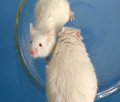Aeromonas veronii and the leech Hirudo
Characteristics of the symbiont/pathogen
Aeromonas veronii is a gram-negative, rod shaped bacteria[1] and has a genome size of about 4551783 base pairs long[2]. It belongs to the Kingdom of bacteria, the phylum of proteobacteria, the class gammaproteobacteria, the order Aeromonadales, the family Aeromonadaceae, and the genus Aeromonas[2].
Characteristics of the host
What host/s is/are involved? Is there host specificity? Are there secondary reservoirs?

Host-Symbiont Interaction
What kind of interaction do host and symbiont have? How is the host affected by the relationship? How does the host acquire and transmit the symbiont? Is the interaction obligate or facultative?
Molecular Insights into the Symbiosis
Describe molecular/genetic studies on the symbiosis.
Ecological and Evolutionary Aspects
What is the evolutionary history of the interaction? Do particular environmental factors play a role in regulating the symbiosis?
Recent Discoveries
Describe two findings on the symbiosis published within the last two years.
References
[Sample reference] [[1] Seemanapalli SV, Xu Q, McShan K, Liang FT. 2010. Outer surface protein C is a dissemination-facilitating factor of Borrelia burgdorferi during mammalian infection. PLoS One 5:e15830.]
Edited by [Gabrielle Woodford], students of Grace Lim-Fong
This template is just a general guideline of how to design your site. You are not restricted to this format, so feel free to make changes to the headings and subheadings and to add or remove sections as appropriate.
